To me, a submissive horse is one that is supple, loose, happy and reacting on my dressage training aids. The whole horse swings, so it’s easy to get into his rhythm.

The horse’s paces go from the hind legs toward the bit, and he carries me. Mentally, my horse is relaxed, but he concentrates on me and waits to see what I want him to do. He enjoys the work so he is willing. When my horse is submissive, he is not separate from me. We are one being, however, riding isn’t always that easy. There are times when I start a new horse or get one that has been ridden in another way. The horse might not directly understand what I want and he might be stiff, which makes the work hard. The first problem is usually that the hind legs aren’t working. As a result the horse doesn’t react on my first aid, and he becomes stiff in the mouth. I have to ask again and again, and the horse may get anxious when I use aids that ask even in an encouraging way. My leg aids say, Come on! You can do it!
When the horse finally takes the contact, three things happen:
1. For a moment, he may get strong,
2. Then, the contact balances the horse more on the hind legs, and
3. Finally, he becomes soft in the hand.
Once this happens, the horse learns that working with me is comfortable. He reacts on my aids, and then we can do movements. Even when the horse doesn’t do movements perfectly, he tries to understand what I want. A dressage horse’s ability to learn movements is much easier when the horse is submissive. But how does the rider make his horse submissive?
Rider Position
A horse’s response can never be better than the rider’s aids, and the rider’s aids can only be as good as her seat. The correct position of the rider is what makes the aids clear. If you want to have a supple and loose horse, you must have a supple and loose body without stiffening or sitting against the rhythm or the motion. Even when you ask your horse for more energy, you must stay loose. And when you need to have more contact for a moment, you still must stay loose. Then all the aids, including the weight aids, work together. Otherwise, it’s impossible for the horse to balance.
The FEI definition describes submission as “obedience, but not subordination.” It means that although I’m the leader, I am a benevolent leader, not a forceful or violent one. That said, when my aids are precise and kind, I am quite persistent that my horse obey them. That is, my aids are “consequent.”
Clear and Consequent Aids
When the horse is free in a herd, he always has a trustworthy leader he can rely on. Now, under saddle, the rider must be the leader. When a horse clearly understands what the rider wants, he is happier. He trusts a rider who is “consequent,” meaning a rider who expects a consequence from her aids is easiest for the horse to understand; she becomes trustworthy because she is consistent.
If the rider is uncertain, the horse doesn’t experience a clear consequence for ignoring the aids, and as a result, the horse’s understanding suffers, and he can’t fully trust the rider. There can only be harmony when the horse has a clear leader that he responds to without question. The horse needs to know precisely what you want, so it’s best to be clear. For example, if I want to canter from walk, I give one aid, and the horse has to react on the first aid with consequence, rather than deciding for himself when the canter will begin. My horses have confidence in me, which is why they pay attention to me.
Exercises for Submission
One of the reasons why my horses have confidence in me is they know what to expect. The warm-up and work sessions have interesting variations, but the general routine is always the same. I always start by loosening my horse in a free walk for at least 10 minutes but usually longer.
Warming up. The warm-up is the same for horses of all ages. I start with a normal trot rising in a comfortable tempo so my horse can get warm. I don’t go too fast because that would create tension, but within my horse’s normal trot, I ride invisible half halts–only to feel my horse’s reaction, so if I want a moment of collection, I know my horse will come back. Also, I ask for slightly more within this normal trot. I close my leg a bit to confirm that he is in front of my leg and that he wants to go forward from his hind legs.
Next, I do transitions on a 20-meter circle. With a young horse, I might do one round of trot and then one round canter. With a more educated horse, I will do the transitions more frequently. During these transitions, I improve my horse’s reactions so we can be very coordinated.
When the horse starts to warm up, I ride the figure-eight. You don’t want the work to be boring. When you do different things, the horse finds the work fun, and he concentrates more on you. In the figure-of-eight, I give a little half halt each time I change the rein to I make sure I can feel my horse’s balancing reaction.
During this part of my warm-up, I don’t do any exercise that requires my horse to cross his legs, such as leg yield or shoulder-in. Also, with a young horse, I never do any sitting trot. In the middle of the horse’s
4-year-old year, I start sitting, bit by bit, after the warm-up.
I take frequent breaks and let my horse walk on a long rein so he can relax for several minutes. If your horse is tired, he won’t enjoy the work. Also, he won’t be able to concentrate, be loose, swing through his back or carry weight on his hind legs. He needs to have enough power in order to have these positive qualities. I also stretch my horses often in trot and canter.
More transitions. I learned the principle behind transitions from Ingrid Klimke, and I find that they are the best exercise for developing the horse’s balance. Here’s an example of what you want to achieve when you ride a trot-walk-trot exercise:
- As you do the downward transition from trot to walk, you close the horse’s frame and bring his hind legs under his center of gravity so he engages and carries more weight behind.
- Then, when your horse is engaged, you go directly to trot again. In that upward transition, you want to open the neck a bit, but keep the hind-leg carriage you had in the walk.
With transitions that achieve this engagement, horses learn, step-by-step, to carry more weight with the hindquarters in all the work, whether they are in a working trot or extended trot. After all, the horse can only do a medium or extension if he is able to carry weight on the hind legs, otherwise, he is running. When horses go more forward, they must learn to keep carrying the weight behind, rather than going on the forehand.
The work session. After the horse is warmed up, I ask for leg yield or shoulder-in to supple the horse further and continue to encourage him to react on my leg aids. Half pirouettes in walk also help the bending as well as the horse’s reaction to, and coordination with, the rein, weight and leg aids. On some days, I continue with movements that I want to improve or I go on to teach my horse something new. But anytime I feel the horse is getting tense in his work, I do a walk break or let him stretch so he can relax. In fact, there are days, when we only do stretching.
After the work session, it’s important that I allow my horse to stretch in trot-canter transitions, and then I walk him again, long enough to cool him down.
Contact for Submission
During all the work, be aware that the horse’s mouth is sensitive, so the contact should be soft and steady, and the rein aids should be used with feeling. When the rider takes the rein, the horse should follow. But, in the next moment, when the horse yields and gets soft to the rein aid, the rider must give the rein. As a result, the horse learns, step-by-step, that when he is submissive to the aids, he is comfortable and will be allowed to move freely. He trusts the rider as his leader. He carries himself without restriction, and his whole body swings in rhythm, making horse-and-rider harmony easy.
Helen Langehanenberg, a former champion pony rider and student of Ingrid Klimke, was given the ride on Damon Hill in 2005 when Klimke was injured, and the pair won the World Championship for 5-year-olds. Now training with Klaus Balkenhol, she was the reserve rider for the German Olympic team in 2008 on her mare Responsible. She and her husband, Sebastian, a Pferdewirtschaftsmeister, teach and train in North Rhine-Westphalia (langehanenberg.de).











